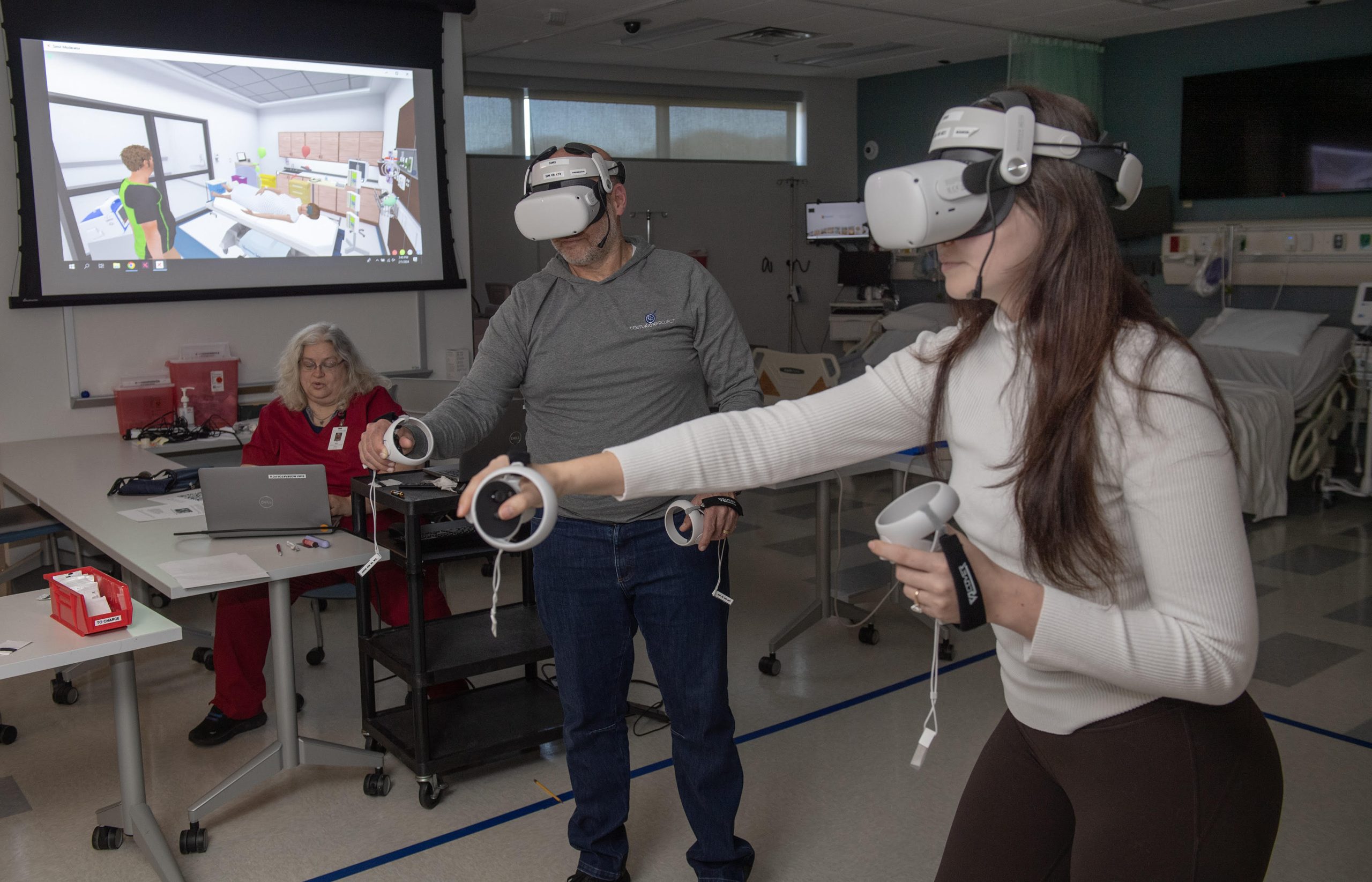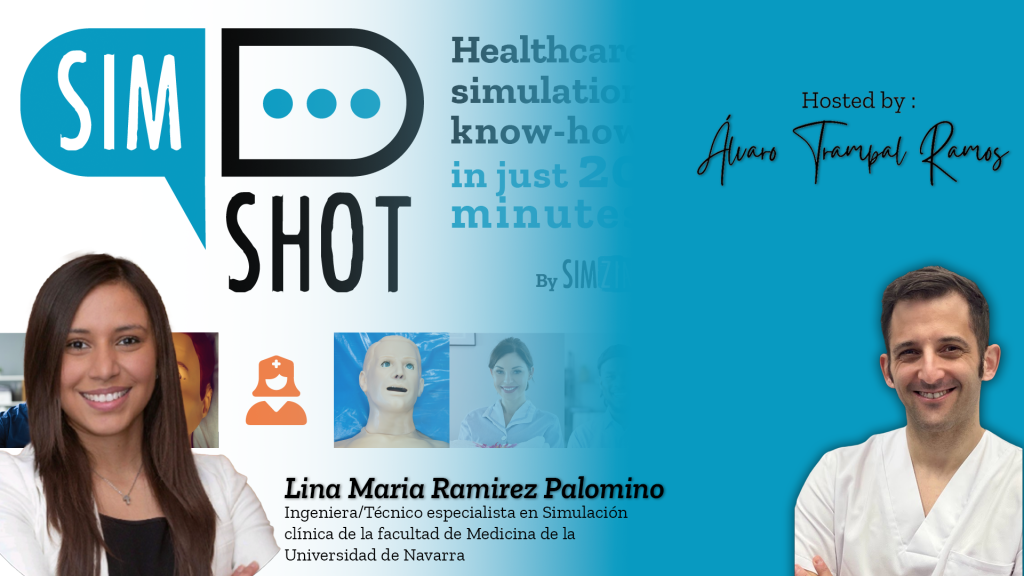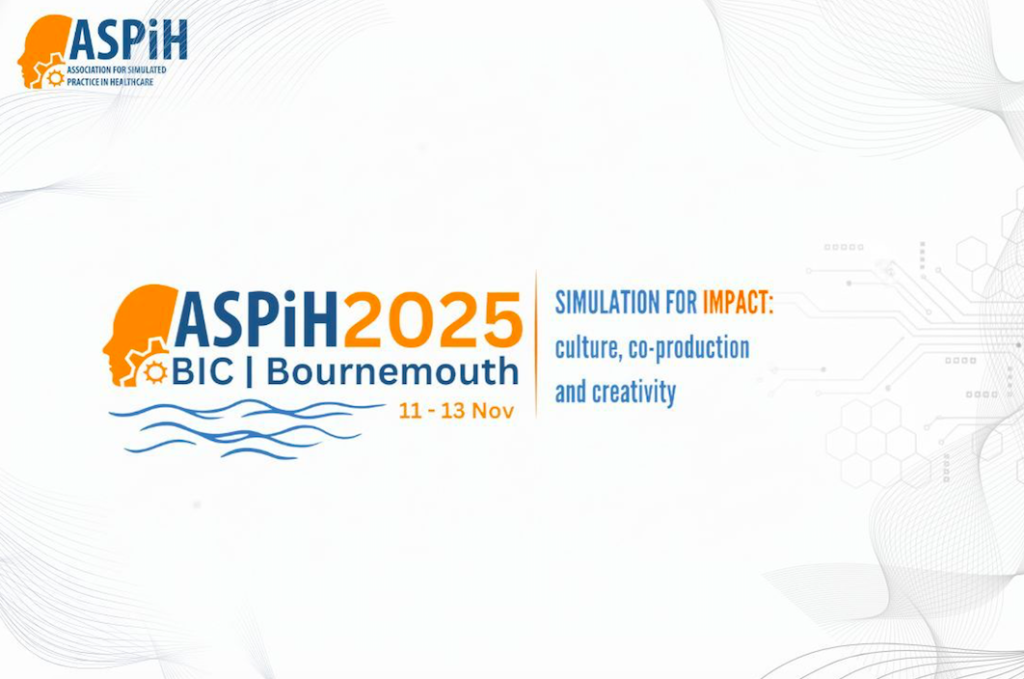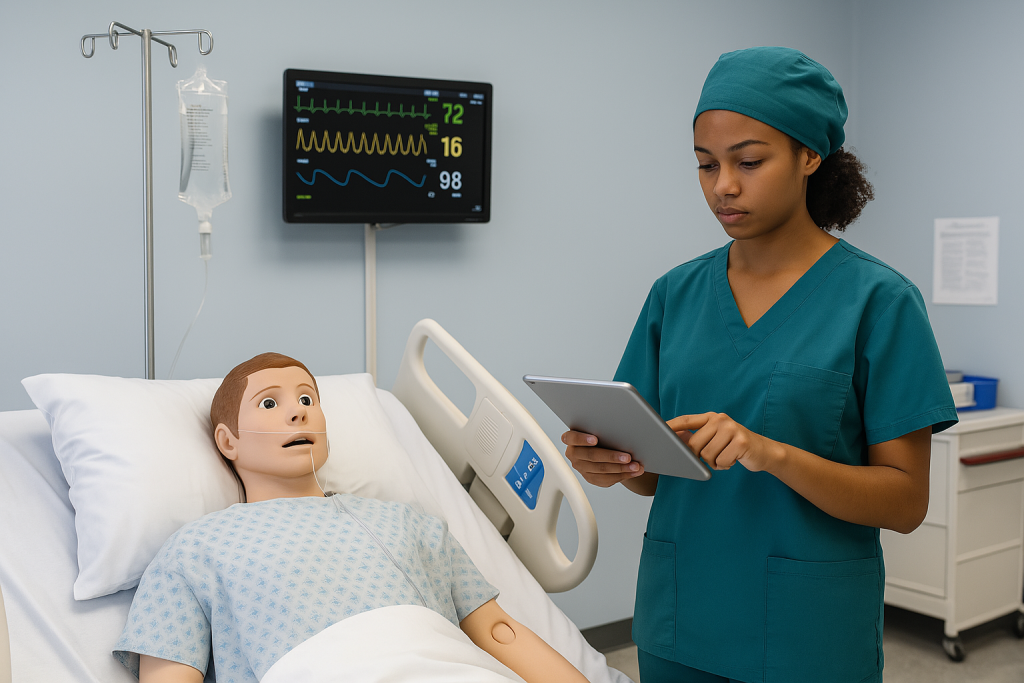Introducing virtual reality (VR) in medical education, specifically with SimX, faces significant challenges. Effective implementation requires preliminary training for both students and faculty to ease the VR learning curve and reduce anxiety. Class size limitations, diverse student backgrounds, and technical issues complicate VR integration. Small groups and dedicated roles enhance engagement, but resource demands remain high. Jill Ellern tells us about her experience.
Like other simulation technology, introducing virtual reality into both classroom and lab environments is quite difficult. Attempting to incorporate a multiplayer VR scenario medical software such as SimX into large classroom settings has revealed both its potential and considerable challenges.
Practice and training before running a VR scenario
Before delving into the complexities of implementing it in classrooms or labs, it is important to include a crucial preliminary step that shouldn’t be overlooked when implementing VR: a dedicated sandbox or training time for both students and faculty. This preparatory phase is essential for several reasons. Firstly, it allows users to become familiar with the VR interface, controls, and environment without the added pressure of a clinical scenario. It is important to incorporate it into the student’s first year’s class schedule with enough time to get familiar with the technology before more formal scenario sessions are expected. This familiarity significantly reduces cognitive load during actual simulations, attempting to enable the participants to focus more on the medical aspects rather than struggling with the technology. For students, this training time also helped alleviate anxiety about using VR and builds confidence in their ability to navigate the virtual space.
It is even more important for faculty members, particularly those in moderator roles, to have practice time as it allows them to master the controls, understand the limitations and capabilities of the software, get to know the scenario from the students’ perspective and develop strategies for guiding students effectively within the virtual environment. Moreover, this sandbox/training period provides an opportunity to identify and address any potential issues with motion sickness or discomfort, allowing for adjustments or alternative arrangements before the actual classroom scenarios begin. In addition, the software and scenarios don’t always have all the possible dialog or support questions that the students might have during the live practice. By investing time in this preliminary training, the faculty can significantly enhance the effectiveness of VR-based simulations, ensure smoother execution of scenarios, and create a more positive and productive learning experience for all involved. This approach not only maximizes the educational value of VR technology but also helps in building a supportive and confident user base among both students and faculty.
The number of students in a class vs how many can be in VR at one time
After the training sessions, the actual mechanics of using VR in the classroom or lab become apparent. The fundamental obstacle is that a traditional classroom or lab environment can have many more students than can fit into a single VR scenario at any one time. The size of the scenario “room” can only hold about 2 to 3 students at a time making a classroom of 35 to 40 students take a long time, difficult or even impossible if you want everyone to participate within the constraints of a typical class or lab session.
The first thought is to have 2 or 3 students participate directly using VR headsets while projecting their experience onto an overhead screen using another PC for the rest of the class to observe. SimX allows for multiple moderators within the same running scenarios and projecting the action from various angles. It is easy to move the chairs around to create a dedicated space in the front of the classroom, mark it off with tape and try to utilize the software with student volunteers. Even if you have the dedicated VR space in another room and project the action into another room with a large number of students watching, the same unsuccessful results might be experienced.
Diverse background of healthcare students
It is possible that one of the critical factors complicating the implementation of SimX is the diverse background of healthcare students, particularly in nursing programs. Within a single class, there is a wide spectrum of experience and knowledge levels. This can range from students fresh out of high school with limited healthcare exposure to those returning to school after careers in Emergency Medical Services (EMS) or as Licensed Practical Nurses (LPNs). This diversity, while valuable in many aspects of education, presents unique challenges in maintaining engagement and managing the classroom effectively. This is heightened when using VR.
VR learning curve
An additional challenge that might be encountered is the learning curve associated with the VR technology itself. Despite a common assumption that today’s students are inherently tech-savvy, and an initial training time, you will find that learning to use VR equipment, controllers, and navigating virtual space is often a new experience for many. While some students may have gaming experience, this doesn’t necessarily translate directly to proficiency with VR technology in an educational context. This learning curve applies not only to students but also to faculty members who need to understand the technology both as moderators and as participants in the virtual room created by the software.
Physical reactions to using and watching VR
Moreover, it has been observed that some students don’t tolerate the VR experience well, in the headset and watching online, especially from point-of-view perspectives. A subset of participants can experience vertigo or motion sickness when using the headsets or watching the screen, which not only disrupts their learning experience but can also be physically uncomfortable. This issue further complicates the implementation of VR technology in a classroom setting, as we need to be prepared with alternative learning methods for students who cannot use the VR headsets or even watch the screen due to these physical reactions.
Peer pressure issues
Another significant issue that can be encountered is the psychological barrier some students face when using the VR headsets in front of their peers. The feeling of being “on display” while in the headset can create anxiety and reluctance to participate. This peer pressure effect can lead to some students avoiding the VR experience altogether, which defeats the purpose of using this innovative technology for their education. It’s crucial to create a supportive and non-judgmental environment to encourage participation, but this remains a challenge in larger group settings.
Disengagement and disruption in the audience
The varied backgrounds of students, combined with the novelty of VR technology and these additional psychological and physiological factors, can lead to a range of reactions to the VR scenarios. Some students, particularly those with more healthcare experience, may find certain simulations less challenging and become bored or distracted. On the other hand, students with limited prior exposure to healthcare settings or VR technology might feel overwhelmed by the complexity of the scenarios and the interface. This disparity in experience levels can make it difficult to control the classroom environment, as students may disengage, become disruptive, or struggle to participate meaningfully.
But the primary challenge encountered was maintaining engagement and focus among the large ‘gallery’ of observing students. Despite the innovative nature of the technology, students not directly involved in the VR simulation often became disruptive or distracted. This not only diminished the educational value for the observers but also negatively impacted the experience of those actively participating in the simulation. The immersive nature of VR, while a strength in small groups, became a barrier in this larger setting as it created a disconnect between the participants and observers.
Team approach to using VR with a group
Successfully SimX session with a gallery of students requires a team of at least three individuals, each with specific roles. This staffing requirement adds another layer of complexity to implementing SimX in educational settings, particularly when working with larger class sizes and diverse student backgrounds.
- A faculty member to operate the moderator function, controlling the scenario including dialogue and actions of the VR characters. This role is crucial for guiding the simulation and ensuring it aligns with the learning objectives. The teaching faculty member in this role needs dedicated time to become proficient with the software and understand how to effectively moderate within the virtual environment.
- An instructor dedicated to managing the students in the gallery. This person is responsible for reviewing learning objectives, encouraging gallery students to offer suggestions and assistance to those in the headsets, and maintaining engagement among the observing group. This role becomes particularly crucial given the diverse backgrounds of the students, as the instructor must find ways to challenge more experienced students while supporting those who might be struggling.
- A technician to handle the technological aspects of the session. This includes projecting the overhead view of the VR scenario, moving the view around to get the best view of the action, assisting students with putting on the VR glasses, and orienting them to the center of the VR space so that they don’t trip over each other in physical space. The technician’s role is vital in ensuring smooth operation of the equipment and troubleshooting any technical issues that arise. They also play a crucial role in helping students overcome the initial learning curve associated with the VR technology.
Break the gallery into smaller groups with tasks to keep them engaged
After recognizing these challenges, you might want to experiment with various approaches and eventually discover a more effective method for utilizing SimX in our educational program. Breaking the larger class into smaller groups of no more than 10 students can dramatically improve the learning experience and outcomes. This smaller group size allows for more focused engagement and much more effective classroom management. It also provides an opportunity to group students with similar experience levels together, allowing for more tailored learning experiences and more individualized support in mastering the VR technology.
In these smaller sessions, implementing a strategy of assigning specific roles or procedures to each student within the group might be helpful. For example, while one or two students might be in the VR headsets, others are given tasks such as monitoring vital signs, preparing equipment, or making diagnostic suggestions. This approach ensures that every student in the headset and in the gallery has a clear purpose and an active stake in the scenario’s outcome, even if they’re not wearing a headset. It also allows for the assignment of roles that challenge each student appropriately based on their background and experience level.
The smaller groups also facilitate more meaningful debriefing sessions after each simulation. Students are more comfortable sharing their observations, questions, and insights in this more intimate setting, leading to richer discussions and deeper learning. The smaller group size also allows instructors to address the varying levels of understanding and experience more effectively, including any challenges students face with the VR technology itself.
Challenges with smaller group size
However, this small-group approach is not without its own challenges. It requires significantly more time and resources to cycle all students through the VR experience. It also demands more intensive preparation from instructors, who need to design meaningful roles and tasks for the group, considering their diverse backgrounds and varying levels of comfort with the technology. Additionally, it requires careful scheduling and potentially more staffing to manage multiple small groups effectively.
Despite these logistical challenges, the improvement in student engagement and learning outcomes has been substantial. Students report feeling more involved in the learning process and better able to apply the skills and knowledge gained from the larger group SimX scenarios. The smaller group size and more tailored approach help to mitigate the issues of boredom, distraction, or feeling overwhelmed that we observed in the larger class setting. It also allows for more personalized guidance in mastering the VR interface, which has proven crucial for maximizing the educational benefits of the platform.
Promise of VR scenarios
The SimX platform itself continues to offer valuable, immersive clinical scenarios that provide students with the opportunity to practice in a risk-free environment. The realism of the simulations, combined with the ability to repeat scenarios and learn from mistakes, remains a powerful educational tool. However, it is critical to have thoughtful implementation strategies and the need for dedicated time for both students and faculty to become proficient with the technology.
Benefits of watching vs participating in VR
In the context of VR scenarios, observing versus participating presents a nuanced comparison. Watching a VR simulation, while not as immersive as direct participation, still offers substantial benefits over no exposure at all. Observers can gain valuable insights into procedures, decision-making processes, and spatial awareness within the simulated environment without the potential distractions or pressures of active engagement. This passive role allows for a broader perspective, enabling viewers to notice details that participants might miss while focused on their tasks. Additionally, watching a VR scenario can serve as an effective primer, mentally preparing individuals for future hands-on experiences by familiarizing them with the virtual environment and expected challenges. It’s particularly useful for those who might experience discomfort with VR technology, allowing them to acclimate gradually. However, participation within the actual VR headsets provides a more visceral, embodied learning experience with heightened sensory engagement and agency. While observation in VR is certainly valuable, especially when full participation isn’t feasible for all, it lacks the depth of sensory input and the crucial element of decision-making under pressure that participation offers. Ultimately, a combination of both observation and participation in VR scenarios would likely yield the most comprehensive training experience.
Refining the approach
Moving forward, continuing to refine your approach, explore ways to maximize the benefits of VR while working within the constraints of your educational setting. This includes investigating methods to better integrate the VR experiences with our broader curriculum, developing more comprehensive pre- and post-simulation activities, and finding ways to scale the small-group model more efficiently. Remember to focus on developing strategies to effectively engage students with diverse backgrounds and experience levels, ensuring that each student can benefit fully from the VR experience. Additionally, creating more structured orientation sessions for both students and faculty can help them to become more comfortable with the VR technology before diving into complex medical scenarios.
Conclusion
While SimX and similar VR platforms hold great promise for medical education, it is important to carefully consider implementation strategies. Factors such as group size, level of student involvement, integration with traditional teaching methods, staffing requirements, the diverse backgrounds of healthcare students, the learning curve associated with VR technology, physiological responses to VR, and psychological barriers to participation all play vital roles in successfully leveraging this technology to enhance learning outcomes in healthcare education. The need for a three-person team to effectively run each session, coupled with the importance of dedicated sandbox/training time for both students and faculty, underscores the resource-intensive nature of this educational approach, but also speaks to its potential for providing a rich, immersive learning experience when properly implemented.By addressing the challenges posed by diverse student backgrounds, varying levels of healthcare knowledge, the novelty of VR technology, and individual student needs and comfort levels, you can harness the full potential of these technologies. Using VR, such as SimX software, can create more engaging, effective, and inclusive learning experiences for all healthcare students. Plan to continue to refine your approach with the commitment to bridging the gap between traditional education methods and cutting-edge VR technology, ensuring that our students are well-prepared for the complex, technology-driven healthcare environments they will encounter in their future careers, while also being mindful of the limitations and challenges that come with implementing such technology in large classroom settings.
READ ALSO







































